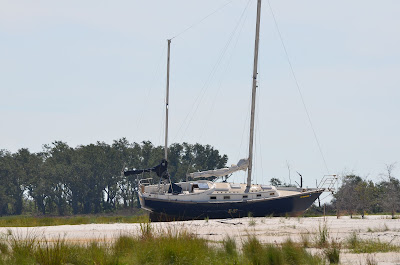As many readers here know, I've been writing books for years and now have seven nonfiction titles published, all of them related in some way to the subjects of boats and/or survival on or near the water. I have now written a novel, which has been published by Ulysses Press, of Berkeley, California, and has been released in
print form this week (the
Kindle and other E-book formats will be available on or before July 10).
I wanted to mention this here for those of you who may not visit my other sites, as this novel is a post-Apocalypitc tale in which a 36-foot Wharram catamaran is featured in much of the action. Here's a look at the cover:

While part of the story takes place in New Orleans and later involves travel by canoes in the river swamps of south Mississippi, as this cover image suggests, the other part begins in the Caribbean, where Artie Drager, one of the main protagonists is on an offshore passage with his brother, who is a yacht delivery skipper. While they are still far from land between Martinique and St. Thomas, a series of powerful solar flares shuts down GPS satellites and all other communications, and destroys practically all complex electronic circuitry. Artie, who was just visiting the islands on a short vacation, is now cut off from his only daughter, who is a college student at Tulane University, in New Orleans, and is frantic to get back to the mainland and find her after the pulse event.
They continue on to St. Thomas, where they discover that the power grid shutdown is widespread and complete, and leave the yacht there as Artie's brother, Larry, has contracted to do. In his spare time between delivery jobs, Larry has been building a Wharram Tiki 36 catamaran as his own personal boat, and they make their way to the build site on Culebra to quickly ready it for launch, despite the fact that it is still in primer and most systems are uninstalled. The big, shallow-draft Wharram cat will have many advantages in this new world of chaos and uncertainty, and confident they can reach New Orleans and find Artie's daughter, they sail for Florida and the Gulf beyond. Here's a description from the press release from my publisher:
A Compelling Novel of Surviving the Collapse of the Grid
When an intense electromagnetic pulse instantly destroys the power grid throughout North America, there's no guarantee of survival. And that's what Tulane University student Casey Drager quickly realizes as desperate citizens panic and anarchy descends. Surrounded by chaos, Casey must save herself from the havoc in the streets of New Orleans.
Meanwhile, thousands of miles away, her father, Artie, finds himself warding off pirate attacks and tackling storms on his Caribbean sailing vacation-turned-nightmare. Using the stars to guide him toward the states, he wonders if he'll ever be able to find his daughter.
The first novel from best-selling survivalist author Scott B. Williams, The Pulse is a thrilling narrative of survival amid the violence and disorder following the catastrophic destruction of America's power grid. "The Pulse reveals what it would take to survive in a world lit only by firelight," Williams explains. "Where all the rules have changed and each person must fend for himself."
I've been wanting to write a novel with lots of sailing (and canoeing) action for as long as I've been writing, and now I've finally gotten around to it. If you decide to check it out, I hope you enjoy it and that you will give me your feedback. There will likely be a sequel as the ending opens the door for the next part of the story to continue. Here's a review that was posted yesterday on Boat Bits, one of my favorite sailing blogs, which is written by a full-time liveaboard cruiser and former Wharram owner:
http://boatbits.blogspot.com/2012/06/pretty-good-book.html


















